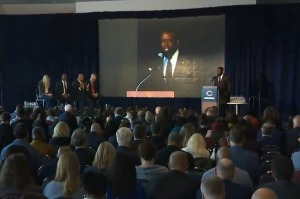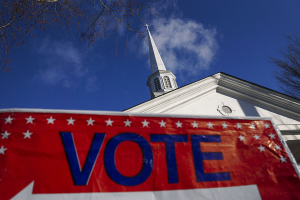Close to Ground Zero, Lower Manhattan Community Church Rooted in 9/11 History
Born and raised in New York City, Pastor Gregg Farah knew even before the tragedy of 9/11 that he would someday be leaving his job as a youth ministry leader at a Southern California megachurch to plant a church in his hometown.
Farah, along with his wife, just didn’t know when.
His stay in California was originally just about going to college, Farah said. However, he and his wife ended up attending and becoming leaders at Saddleback Church in Orange County. Farah became a youth ministry leader in 1999 and was under the guidance of the church’s well-known lead pastor, Rick Warren, and highly-regarded youth ministry pastor, Doug Fields.
“My plan for staying out west was to finish my 15-year west coast stint, but always looking to get back home,” Farah told The Christian Post. “We didn’t know where or when. We just knew that was the big picture.”
Farah saw the collapse of the World Trade Center twin towers as many did on the morning of Sept. 11, 2001, on TV.
“As a New Yorker and as a future church planter I just started calculating the thousands of people that were in those buildings and I was imagining the worst,” he recalled. Shortly after the attacks, flights in the United States including those scheduled to New York were grounded for two days, and travel was still limited in the days to come. However, Farah was one of the first from California to arrive in New York after 9/11.
“I was on the first plane that was allowed to fly out of California to New York,” he said. After arriving, he came as close to ground zero as was allowed at the time.
“I remember just being kind of numb. I remember the smell. It was still burning,” he said. “A month later, my wife and I (on another trip) were able to go down and tour and able to get a lot closer.”
Also, at the time, Warren and other leaders from Saddleback were talking about ways to serve in New York. It was then that Farah and his wife began to realize it might be time to do their planned church plant.
“Suddenly, I felt like OK, the timing seems to have been sped up to now. I think we found our location,” he said.
Prior to visiting NYC in preparation for a church plant, Farah had only been to the downtown area twice as a youth. Once, to the top of the World Trade Center, and once to the top of the Statue of Liberty, both times with grandparents, he said.
On the first trip back with his wife, they had the opportunity to tour more of downtown with a relative.
“I remember my wife and I feeling like we’re home. We had never walked these streets, but we felt like oh, my goodness, there’s no question we were supposed to be here,” he said.
After several more trips, on April 15, 2002, Farah and his family moved to Manhattan. Within the next couple of weeks, they began a Bible study in their apartment with plans to start a church to be called Mosaic Manhattan.
The first Bible study had seven people attending. The group increased to between 20 and 30 people before it was moved to the Embassy Suites, a short distance away, Farah said.
Mosaic Manhattan officially opened on March 9, 2003, at P.S. 89, an elementary school on Warren Street, and less than a mile from ground zero.
Now called Lower Manhattan Community Church, and led by Pastor Ryan Holladay since 2009, the place of worship remains a place for young families and long-time residents to come together in a community that is in a sense, still recovering.
Farah, 44, explained why the church was originally named Mosaic Manhattan:
“Mosaic is just such a great urban picture. Mosaic as an art form is a bunch of broken tile pieces brought together to form something beautiful. Considering that the city is a bunch of broken people from all different cultures, all different backgrounds, all brought together in the name of Christ, just makes a beautiful thing.”
Farah said that for himself and his family, as church planters, the months after the 9/11 tragedy were exciting, but also scary.
“We had never planted a church before. We just knew that this is what we were called to do and this was the season of our life. We just loved the people downtown. And downtown was really new,” he said. “Fifty percent of the Battery Park City population had moved out. It was like a brand new community. You had half that refused to move and a bunch of new people coming in.”
“It was an exciting time, but it was still somewhat of a tense time. I can remember up to two years later being in the park with my kids and having a low-flying plane go by and myself, who was not there during 9/11, and everyone there kind of sheepishly looking on. All of us let out a collective sigh of relief (after seeing the plane was not a problem). That [feeling] just hung in the air, it still does,” he added.
Farah said there was “somewhat of a short window” of opportunity in regards to new churches seeing an increase in attendance in the same way as established churches did after the tragedy.
“For churches that were on the ground and operating on Sept. 12, there was a real influx of people,” he said. However, Mosaic Manhattan didn’t begin the process of launching until six months later. “New Yorkers are already skeptical about a lot of things and so to invite people up to your apartment for a Bible study … that took awhile. We had to build relationships with people, but conversations were definitely readily available.”
Farah said he is thrilled that Holladay, the son of Saddleback’s associate pastor, Tom Holladay, has been leading Lower Manhattan Community since 2009. Holladay, 27, was under Farah's guidance when he was a youth leader at Saddleback.
“It’s fun to pass the baton to someone I have known for years and trust,” said Farah, who is currently the student ministry pastor at Shelter Rock Church in Long Island.
Lower Manhattan Community, which has a relatively small congregation, will be part of Saddleback’s 9/11 Hope & Freedom services this weekend commemorating the 10th anniversary of the attacks on the U.S. Holladay was recently filmed at ground zero for video to be shown during the Saddleback services, he said.
“People definitely have that sense that 9/11 was part of the reason this church is here,” Holladay told CP. “For anybody that lives downtown there is a sense that part of what we are doing here is helping downtown rebuild. Our church has that sense. We are honored to be helping downtown rebuild and to do it in only a way a church can help rebuild – spiritually. That’s definitely part of our DNA.”




























